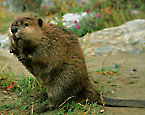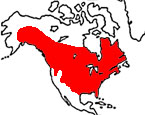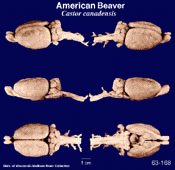|
American Beaver Castor canadensis
Head and body length of C. canadensis is 600-800 mm with
a tail length of 250-450 mm. Both male and female adults weights
range between 12-25 kg., though some have been recorded to weigh
as much as 40 kg. The pelage is unusually dense, and the thick
underfur is overlaid with coarse guard hairs. Color ranges from
glossy brown to yellowish brown above and brown to tawny below.
C. canadensis has short legs and the feet have five digits
with sharp claws. The hind feet are webbed, but the first and
second toe are split. This is thought to aid the beaver with
grooming. All four feet are black, as is the tail. Flattened
horizontally, the broad, paddlelike tail is covered with large
scales and mostly hairless.
Both sexes of C. canadensis have two pairs of large glands
known as "castor glands" located in the area of the cloaca.
These produce an odiferous secretion used to scent mark piles
of stones or mud, thought to be signs for other beavers. In
males, baculum is present, females have four pectoral mammae.
Within the massive skull of the American Beaver,
the incisors are strongly developed. The high-crowned cheek
teeth have flat grinding surfaces and numerous fold, but do
not grow throughout the animal's lifetime.
Being semiaqautic, C. canadensis is found primarily along
streams and lakes with nearby growths of willow, aspen, poplar
(cottonwood), birch and alder. In these habitats they build
complex dams, lodges and canals. The foundation of the dam is
made of mud and stones, with poles (butt ends facing upstream)
and brush added on top. Mud, stones and wet plant material are
used to plaster the structure, with the top rising above water
level. The dam provides an area of deep, still water, where
a lodge can be constructed. This habitat provides C. canadensis
with a safe place from predators and a storage area for food
to be floated without danger of it washing away. The lodge is
constructed in the same manner as the dam, and is usually surrounded
by the water that the dam has backed up. This dome shaped structure
can extend more than 2 meters above the water's surface, having
a diameter up to 12 meters at the base. There is a single internal
chamber with a floor that is above the water level. This is
covered by a thick bedding of dry vegetation. The walls of the
lodge can be 1 meter thick at the base, but are generally much
thinner at the top of the dome. C. canadensis enter the
lodge via one of several underwater doorways which are built
below the winter ice level. American Beavers
living near large rivers may build large terrestrial dens rather
than lodges.
The third component to the American Beaver's
habitat is the canal. These are used to float logs to a pond
and the dams may be used to hold up the water levels in these
canals. Several trails can extend from these canals, over which
beavers carry timbers to the water. These elaborate sequences
of dams, lodges and canals are used by generations of North
American beavers,
and are repaired and used over many years.
C. canadensis uses its lower incisors to fell trees and
then cut them into manageable sections which are pushed to the
water. American Beavers
have also been observed walking on their hind find, carrying
a bundle of twigs in their arms. They are good swimmers, able
to store oxygen and remain submerged for 4-5 minutes, but the
record is 15 minutes. There are various types of dives, one
known as a "quiet dive" is used when the animal is undisturbed.
A "fright dive" is used when the animal is alarmed. To warn
others of danger, the American Beaver
slaps its tail on the surface of the water as it dives.
American Beavers
are nocturnal, and though they do not hibernate, in the northern
part of their range, may only leave the lodge during the coldest
winter months to visit their food cache. The diet consist of
the bark, cambium, twigs, leaves and roots of deciduous trees
such as alder, willow, birch, aspen, and on many parts of aquatic
plants. They particularly like the young shoots of water lilies.
Social groups are known as colonies. These are comprised of
4-8 related individuals including a mated pair and the offspring
from the previous two years. C. canadensis is probably
monogamous, having only one breeding female per colony. Breeding
occurs once each year, mating occurs in January or February
and births occur from April to June. Estrous cycles last for
about 2 weeks, but the females are receptive for only 10-12
hours. Gestation is about 100-110 days, producing an average
of 2-4 young, but as many as 9 babies may be born. Fully furred
babies weigh 230-630 grams at birth and their eyes are open.
They are weaned at about three months, and take solid foods
at just one week old. Sexual maturity of both males and females
is reached at 1.5 - 2 years, and the young adults are usually
forced out of the colony at this time. Life expectancy in the
wild is as long as 24 years, and as many as 50 years in captivity.
C. canadensis is found in Alaska and Canada south of
the Arctic Circle (including Vancouver and Newfoundland), most
of the continental USA (absent from parts of the SW USA and
from most of Florida), extending into N Mexico. Intoduced into
Tierra del Fuego (South America) and Eurasia, including Finland,
NW Russia. Poland, Germany, and Austria.
|



